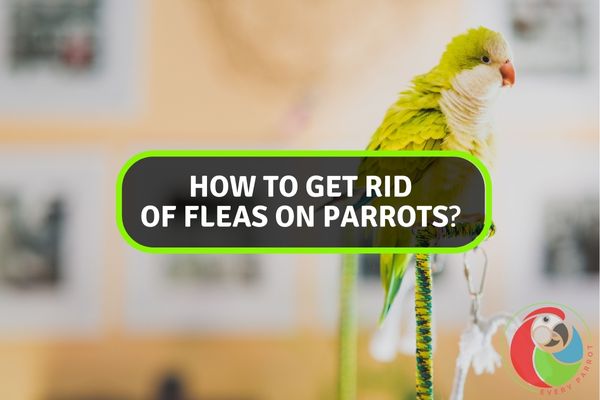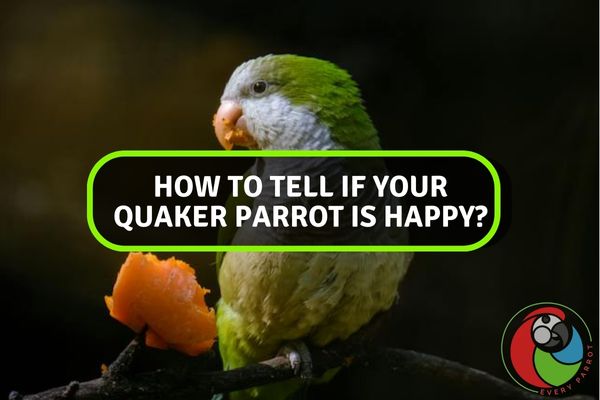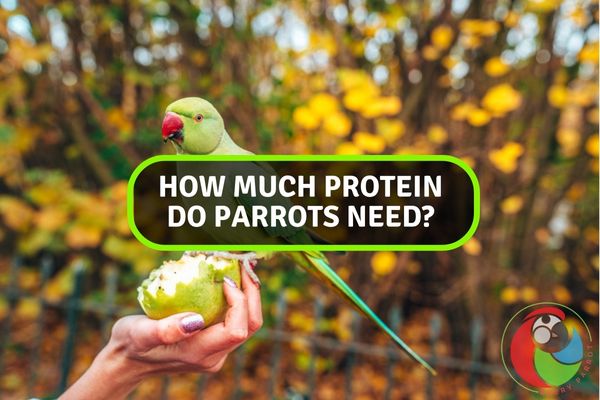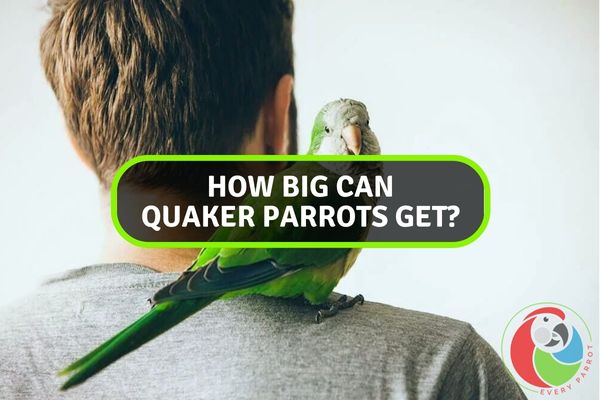What Do Parrots Need in Their Cage?
Creating a comfortable and stimulating environment is essential when it comes to caring for our vibrant feathered friends – parrots. The proper setup of their cage is crucial to their overall well-being and happiness.
In this guide, we’ll explore the key elements that contribute to a parrot’s contentment and health within its confined space. From appropriate perches and diverse toys to a well-balanced diet, understanding the essentials of a parrot’s cage is vital for responsible pet ownership.
Join us as we delve into the nuances of providing a safe and enriching habitat for these intelligent and social birds, ensuring they thrive in captivity while fostering a deep connection between them and their human companions.
Size and Shape of the Cage
Bigger is always better when it comes to parrot cages. Ensure ample space for flying, climbing, playing, and spreading wings fully without touching cage sides.
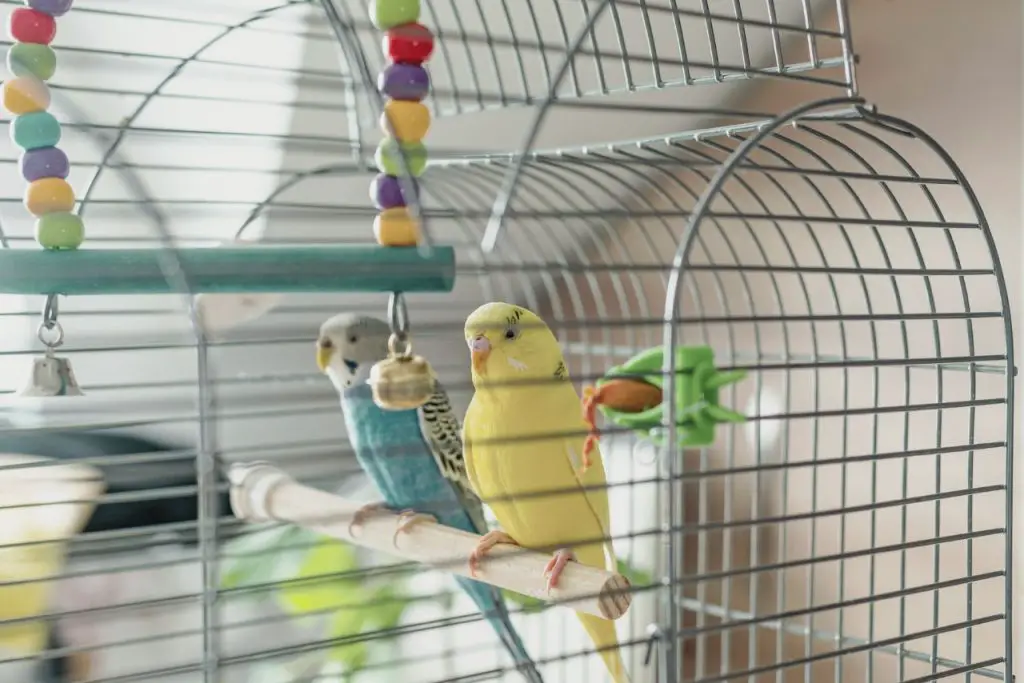
Species-Specific Considerations
Very small parrots like budgies need at least 18” x 18” x 18” cages. Large parrots require minimums of 6-8 feet in length or width to meet their exercise needs.
Minimum Dimensions for Various Parrot Sizes
- Small parrots: 24” x 24” x 36”
- Medium parrots: 30” x 36” x 48”
- Large parrots: 6’ x 3’ x 6’
Importance of Horizontal Space for Movement
Prioritize cage width and length over height, as parrots need more horizontal space for flying back and forth. Multiple connected cages can expand usable space.
Material and Construction
The cage itself must be safe, durable, and well-made to contain active parrots.
Safe and Durable Materials
Look for sturdy stainless steel or powder-coated cages without lead or zinc. Avoid cages with potentially toxic paints or plastics.
Bar Spacing and Placement
Bar spacing between 1/2” and 3/4” prevents head entrapment. Horizontal bars encourage climbing while vertical bars allow for wing flapping.
Secure Locks and Latches
Double check that all doors securely latch, with secondary locks for extra escape prevention. Smart parrots learn to open basic cage latches!
Perches
Perches allow parrots to exercise their feet while roosting. Include a variety of perch types, diameters, and placements to promote foot health.
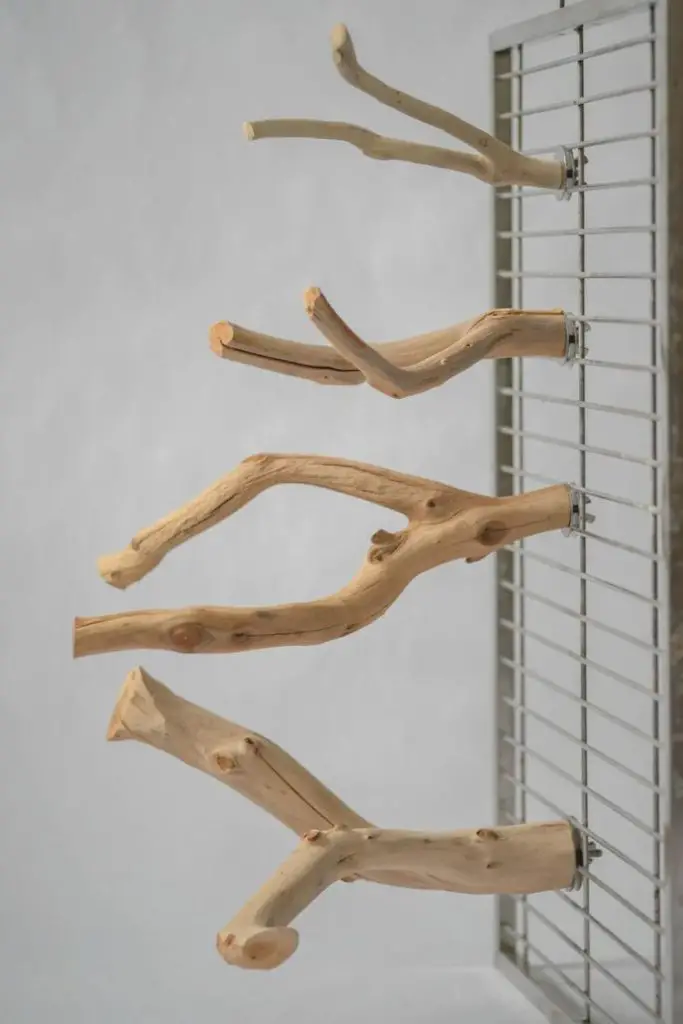
Different Types of Perches
Provide both natural wood branches as well as polyurethane, concrete, or plastic perches. Mixing textures stimulates feet and beaks.
Varying Diameters for Foot Health
A range of narrow to wide perches works different foot muscles. At least 1/2” to 1” diameter is suitable for small parrots and up to 2” for large parrots.
Placement for Exercise and Comfort
Arrange perches at different heights and orientations to allow climbing, flying, and roosting in preferred sleeping spots. Have a “landing platform” near cage doors.
Cage Accessories
In addition to perches, cages need accessories to enrich the space and meet parrots’ needs. Provide:
- Food and water bowls: Heavy, tip-proof bowls suitable for the parrot’s size.
- Toys: Rotate new toys weekly for mental stimulation. Include foot toys, foraging toys, shredders, and more.
- Grooming supplies: Include a bath pan, mister, and materials for filing beaks and nails.
- Hammocks or tents: Provide cozy spaces for napping and hiding.
- Foraging/shredding materials: Add branches, palm leaves, cardboard, etc. that satisfy natural chewing urges.
Cage Placement
Where you place the cage in your home impacts your parrot’s comfort and safety.
Avoidance of Drafty Areas
Protect your parrot from direct air conditioning/heating vents or windows. Birds are very susceptible to drafts.
Exposure to Natural Light
Locate cages near windows that allow natural sunlight without overheating. Proper lighting is vital for health.
Social Considerations for the Parrot
Position the cage in a high-traffic area so your parrot can observe family activities. Being isolated may lead to boredom and behavior issues.
Free Flight Time
While an appropriately sized cage is fundamental, out-of-cage time is also essential. Aim to allow parrots 4+ hours per day of supervised free flight to satisfy their high exercise needs. Invest in a sizeable play stand for safe landing and socializing during free flight time.
Toys and Enrichment
Parrots thrive when mentally stimulated. Provide ample interactive toys to prevent boredom-related issues.

Importance of Mental Stimulation
Rotate puzzles, foot toys, shredders, foragers, bells, and more to keep your parrot engaged and entertained. Lack of stimulation causes stress.
Different Types of Toys
Offer parrots opportunities to shred, chew, toss, and manipulate toys. Include bamboo, loofah, bells, wood, and interactive feeders.
Rotating and Refreshing Toys for Continued Interest
Introduce 1-2 new toys weekly while removing others to maximize novelty. This prevents habituation and continually engages your parrot’s natural curiosity.
Feeding and Watering Stations
Convenient access to food and water is a fundamental requirement in proper parrot cage setup.
Placement of Food and Water Bowls
Position bowls away from perches to avoid contamination. Elevated bowls prevent tossing. Allow enough room for natural foraging behavior.
Selection of Appropriate Feeding Dishes
Use heavy, stainless steel bowls that attach securely to cage sides. Size dishes appropriately for the parrot’s dimensions to prevent spillage.
Ensuring Access to Fresh Water
Check water cleanliness and fullness multiple times daily. Provide filtered water to minimize heavy metal toxicity. Consider attaching water bottles for easy access.
Cleaning and Maintenance
Perform total cage cleaning at minimum weekly for health, with spot cleaning daily. Disinfect per vendor guidelines.
Regular Cleaning Schedule
Remove droppings, leftover food, and debris daily. Weekly, wash all surfaces with soap and water before disinfecting. Rinse thoroughly after cleaning.
Safe Cleaning Products
Use parrot-safe disinfectants like diluted bleach or vinegar solutions. Avoid toxic cleaners like phenols or ammonia that may harm your bird.
Inspecting and Replacing Worn Components
Check for damaged toys, perches, grates, or sharp edges monthly. Replace any cage parts showing wear and tear.
Considerations for Multiple Parrots
When housing more than one parrot, ensure peaceful coexistence with extra space.
Introducing Appropriate Space for Social Interaction
Flock parrots require larger cage dimensions and multiple food/water bowls to prevent resource guarding.
Monitoring Group Dynamics
Watch for signs of stress, aggression, or exclusion. Separate parrots showing hostility. Cage redesign may reduce conflicts.
Ensuring Equitable Access to Resources
Arrange perches, toys, and supplies to allow equal access. Add visual barriers between key resources to reduce competition.
Temperature and Humidity Control
Parrots thrive in specific temperature and humidity ranges.
Ideal Temperature Range
Ambient temperatures of 65-85° F suit most parrots. Move cages away from drafts and provide shade in hot weather.
Humidity Considerations
Ideal humidity is 35-55%. Install hydration systems in dry climates. Avoid exposing birds to humidifier “white dust.”
Providing Shade and Ventilation
Strategically arrange cage covers and curtains to offer sun/rain protection without obstructing airflow which is vital for health.
Conclusion
Creating a conducive environment for pet parrots involves careful consideration of their cage setup. Adequate space, stimulating toys, and a balanced diet are essential for their physical and mental well-being. Regular social interaction and mental stimulation further contribute to a happy and healthy avian companion.
By addressing these fundamental needs, bird enthusiasts can ensure that their feathered friends thrive in captivity, fostering a bond built on trust and contentment. Providing a well-appointed cage is not just a requirement but a gesture of responsible and caring parrot ownership.


